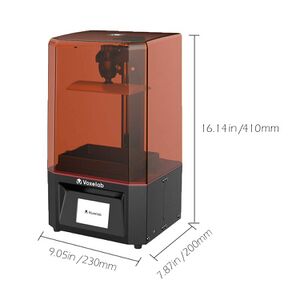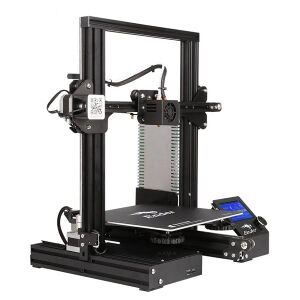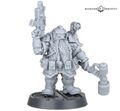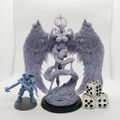3DPrinting: Difference between revisions
30 times cheaper was calculated using local Intercessor prices |
imported>Administrator m 16 revisions imported |
||
| (12 intermediate revisions by 8 users not shown) | |||
| Line 1: | Line 1: | ||
{{ | {{Topquote|“But this constructor is both efficient and flexible. I feed magnetronic plastics — the stuff they make houses and ships of nowadays — into this moving arm. It makes drawings in the air following drawings it scans with photo-cells. But plastic comes out of the end of the drawing arm and hardens as it comes ... following drawings only”| Murray Langster's ''Things Pass By'', hitting the nail on the head on what the tech would become almost 70 years before it actually happened.}} | ||
[[File:3D Printer.jpg|thumb|right|The holy shrine of plastic crack, breath in the incense of freedom and possibilities! (Editor's note, DO NOT do this unless you want to die of lung [[cancer]], and remember to properly ventilate your workspace.)]] | |||
3D Printing is, putting it simply, the home modelers new best friend. [[Laserburn|Discontinued]] games, long since given up hope of reprints, are now almost completely supported by use of hobbyists and printers alike. | |||
The | |||
<small>How many cars will you download?</small> | == Overview == | ||
<small>How many [[Car Wars|cars]] [[meme|will you download]]?</small> | |||
3D Printing is the catch-all term for use of a specialized printer that is fed some form of plastic or other, similar malleable material to turn into a three dimensional object via use of a computer that has a renderable 3D file. The technology was first described in a sci-fi story in the forties, and has since become not only science fact, but a commercial success. Prior to the 2000's, it was mostly only ever used in an industrial capacity, up until 1988 when the company Stratasys came up with the concept of Fused Deposition Modeling (FDM) printing, which brought the complex process to the consumer grade market for a hefty, Forge World-esque price right up until 2009, when the process became public domain, and as a result, more and more companies and builders could get in on the process, making the process still yet far more accessible than ever before. By now, a former $2000 printer may only cost as much as a new video game console. | |||
The accessibility of printer technology, continued availability and sharing of 3d Modeling files, and the complete boredom of lock-downs thanks to the 2020 pandemic has created a boom in 3d printer use for table-top gaming. This is assuming of course you buy your own, and don't just cheap out the work to a company that specializes in 3D printing, like Shapeways. | |||
==== Types of Printing ==== | ==== Types of Printing ==== | ||
Since no one has access to Electron beam melting desktop technology this wiki will cover the most commonly used home printers. | Since no one has access to [[Dark Age of Technology|Electron beam melting desktop technology]] this wiki will cover the most commonly used home printers. | ||
'''Digital Light Processing (DLP)''' | '''Digital Light Processing (DLP)''' | ||
DLP (also called SLA) technology uses a digital light projector screen under a vat of UV resin. DLP 3D printers can image an entire layer of the build all at once, resulting in faster build speeds. While frequently used for rapid prototyping, the fine detail allows for quality minis to be printed. | DLP (also called SLA) technology uses a digital light projector screen under a vat of UV resin. DLP 3D printers can image an entire layer of the build all at once, resulting in faster build speeds. While frequently used for rapid prototyping, the fine detail allows for quality [[Miniatures|minis]] to be printed. However, this type of printing is significantly more complicated, and thus costlier, than FDM printing. | ||
'''Fused Deposition Modeling (FDM)''' | '''Fused Deposition Modeling (FDM)''' | ||
FDM is a common desktop 3D printing technology for plastic parts. An FDM printer functions by extruding a plastic filament layer-by-layer onto the build platform. It’s <s>stinky</s> just use PLA but a cost-effective (up to 30 times cheaper than [[Games Workshop|GW]]) and relatively quick method for producing physical models. This is best for creating terrain or larger models. [[Image:Ender3.jpg|thumb|Costs a fraction of a titan and will make you one]] | FDM is a common desktop 3D printing technology for plastic parts. An FDM printer functions by extruding a plastic filament layer-by-layer onto the build platform. It’s <s>stinky</s> (just use PLA) but a cost-effective (up to 30 times cheaper than [[Games Workshop|GW]]) and relatively quick method for producing physical models. This is best for creating [[Citadel Hard Foam Terrain|terrain]] or larger models. [[Image:Ender3.jpg|thumb|Costs a fraction of a titan and will make you <s>one</s> legions]] | ||
== Impact == | |||
While covered in more detail over at the [[Casting]] page, suffice it to say that for traditional tabletop gaming, the level of disruption is shaping out to be MASSIVE indeed. | |||
Let's start with the relatively innocuous example. You can now design your own custom character for games like DnD and simply print them out, no more need for proxies or drawn cardboard cutouts, and there are even online companies like HeroForge that allow you to make free digital models that you can then buy the STL file for (STL being the digital blueprint you chuck into the printer to make the magic happen). | |||
However, this pales in comparison to the implications this tech has for tabletop gaming involving grand strategy like 40k. What was once plastic crack now becomes plastic tobacco that you grow in your own backyard. Provided that you find the right STLs or just take the time to make your own models, you can have virtually whatever army you could possibly want, from whatever era and with whatever units that were discontinued or shunted. Hell, you can even make proxies that merely resemble the official factions if your heart bleeds so much for faceless corporations that had no compunction against fleecing you via artificial scarcity. | |||
Needles to say, GeeDubs was actually aware of what 3D printing would do to their business and promptly started shitting boulders. A general ban on using printed minis for official tournaments was issued but since most of the games are done in stores or garages, it made little impact. Additionally, GW had begun the process of getting into alternative media such as video games and animation, and while the former has had success (Total War Warhammer being the flagship franchise), the animation side was much more...wanting. | |||
Interestingly enough, 3D printing may have come in the nick of time to offer a viable alternative to the all-digital iterations using Vassal and the like. Since 3D printing is much cheaper after the initial cost of getting the printer and you can print stuff for your friends who are interested in the hobby plus your local community, it is now much easier and viable to have a true flash-and-plastic matches at your local store (or garage/basement/attic) and thus there is not so much need for going on the internet to search for buddies to play with. This of course does not apply to everybody but should help to propagate the hobby far more than was previously possible, or imaginable. | |||
== Gallery == | |||
<gallery> | |||
Image:CountsAs.jpg| A failure of a printed model, eh it still [[Counts As]] a unit. | |||
Image:Resin_Glory.jpg|A handsome [[Squat]] resin model, and through the wonders of SLA you too can print such a masterpiece. | |||
File:Resin chaplain.jpg | |||
File:Painted resin chaplain.jpg | |||
File:1024x1024.jpg|While resin printers can take some time to configure, the end result is ALWAYS worth it | |||
File:GreenResin.jpg | |||
</gallery> | |||
[[category:Model Making]] | |||
[[category:Miniatures]] | |||
Latest revision as of 14:59, 17 June 2023
"“But this constructor is both efficient and flexible. I feed magnetronic plastics — the stuff they make houses and ships of nowadays — into this moving arm. It makes drawings in the air following drawings it scans with photo-cells. But plastic comes out of the end of the drawing arm and hardens as it comes ... following drawings only”"
- – Murray Langster's Things Pass By, hitting the nail on the head on what the tech would become almost 70 years before it actually happened.

3D Printing is, putting it simply, the home modelers new best friend. Discontinued games, long since given up hope of reprints, are now almost completely supported by use of hobbyists and printers alike.
Overview[edit | edit source]
How many cars will you download?
3D Printing is the catch-all term for use of a specialized printer that is fed some form of plastic or other, similar malleable material to turn into a three dimensional object via use of a computer that has a renderable 3D file. The technology was first described in a sci-fi story in the forties, and has since become not only science fact, but a commercial success. Prior to the 2000's, it was mostly only ever used in an industrial capacity, up until 1988 when the company Stratasys came up with the concept of Fused Deposition Modeling (FDM) printing, which brought the complex process to the consumer grade market for a hefty, Forge World-esque price right up until 2009, when the process became public domain, and as a result, more and more companies and builders could get in on the process, making the process still yet far more accessible than ever before. By now, a former $2000 printer may only cost as much as a new video game console.
The accessibility of printer technology, continued availability and sharing of 3d Modeling files, and the complete boredom of lock-downs thanks to the 2020 pandemic has created a boom in 3d printer use for table-top gaming. This is assuming of course you buy your own, and don't just cheap out the work to a company that specializes in 3D printing, like Shapeways.
Types of Printing[edit | edit source]
Since no one has access to Electron beam melting desktop technology this wiki will cover the most commonly used home printers.
Digital Light Processing (DLP) DLP (also called SLA) technology uses a digital light projector screen under a vat of UV resin. DLP 3D printers can image an entire layer of the build all at once, resulting in faster build speeds. While frequently used for rapid prototyping, the fine detail allows for quality minis to be printed. However, this type of printing is significantly more complicated, and thus costlier, than FDM printing.
Fused Deposition Modeling (FDM)
FDM is a common desktop 3D printing technology for plastic parts. An FDM printer functions by extruding a plastic filament layer-by-layer onto the build platform. It’s stinky (just use PLA) but a cost-effective (up to 30 times cheaper than GW) and relatively quick method for producing physical models. This is best for creating terrain or larger models.

Impact[edit | edit source]
While covered in more detail over at the Casting page, suffice it to say that for traditional tabletop gaming, the level of disruption is shaping out to be MASSIVE indeed.
Let's start with the relatively innocuous example. You can now design your own custom character for games like DnD and simply print them out, no more need for proxies or drawn cardboard cutouts, and there are even online companies like HeroForge that allow you to make free digital models that you can then buy the STL file for (STL being the digital blueprint you chuck into the printer to make the magic happen).
However, this pales in comparison to the implications this tech has for tabletop gaming involving grand strategy like 40k. What was once plastic crack now becomes plastic tobacco that you grow in your own backyard. Provided that you find the right STLs or just take the time to make your own models, you can have virtually whatever army you could possibly want, from whatever era and with whatever units that were discontinued or shunted. Hell, you can even make proxies that merely resemble the official factions if your heart bleeds so much for faceless corporations that had no compunction against fleecing you via artificial scarcity.
Needles to say, GeeDubs was actually aware of what 3D printing would do to their business and promptly started shitting boulders. A general ban on using printed minis for official tournaments was issued but since most of the games are done in stores or garages, it made little impact. Additionally, GW had begun the process of getting into alternative media such as video games and animation, and while the former has had success (Total War Warhammer being the flagship franchise), the animation side was much more...wanting.
Interestingly enough, 3D printing may have come in the nick of time to offer a viable alternative to the all-digital iterations using Vassal and the like. Since 3D printing is much cheaper after the initial cost of getting the printer and you can print stuff for your friends who are interested in the hobby plus your local community, it is now much easier and viable to have a true flash-and-plastic matches at your local store (or garage/basement/attic) and thus there is not so much need for going on the internet to search for buddies to play with. This of course does not apply to everybody but should help to propagate the hobby far more than was previously possible, or imaginable.





